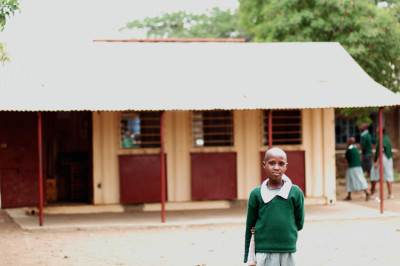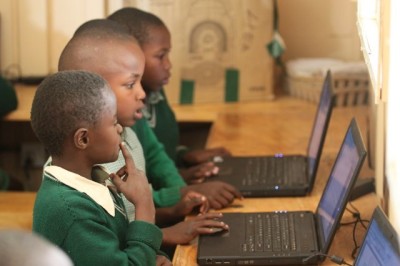Kenya Kids Can operates solar-powered computer centers in public primary schools that often don’t have electricity or running water.
The Importance of Technology Education
 “We have heard of these things, but we have never seen one,” a 7th grade girl at a remote school on the valley floor said when asked what she knew about computers. It was the day KKC opened a computer lab at her school, and excitement hummed in the air. For a school that is still 5 km away from the nearest power lines, the opportunity to have an education in technology had seemed impossible.
“We have heard of these things, but we have never seen one,” a 7th grade girl at a remote school on the valley floor said when asked what she knew about computers. It was the day KKC opened a computer lab at her school, and excitement hummed in the air. For a school that is still 5 km away from the nearest power lines, the opportunity to have an education in technology had seemed impossible.
In a world that is becoming increasingly digital, it is hard to imagine an education without technology. Yet, that is what most students face in rural Kenya. In schools that normally don’t have power, running water, libraries, or a host of other essentials often associated with a school, children grow up in a world that is passing them by. This puts them at a significant disadvantage pursuing employment, and impacts the paths available to them in the future.
So in addition to partnering with the community to help them feed their children, Kenya Kids Can also operates solar-powered computer centers in public primary schools. Our tag line is “feeding and teaching the world changers of tomorrow,” and we know that these children will have a hard time leading their communities, Kenya, or the world if they do not know what a computer can do and how to operate one.
FAQs About How the Computer Program Works
• Does KKC provide everything or is this a partnership with the schools?
This is a partnership with the schools where KKC provides the things the schools are not able to supply and the schools furnish the rest. The schools are responsible for hiring a watchman for the center, paying the housing allowance of the computer teacher, and routine maintenance of the structure. They also adjust the schedule of their school day to incorporate computer classes as a part of the normal academic program.
• What is taught in the centers?
One of our primary goals is to support the good work of the Kenyan educational system and not to replace it. This means that we do not use our centers for teaching math or reading, which is already taught in the classroom. The primary focus is teaching children to operate a computer and to learn how to use a word processor, spreadsheet, and presentation software.
• What are the other benefits of the centers?
Here are a few other benefits we are seeing in our centers.
 A different way of learning. “I like computer class,” a student told our founder, Steve Peifer. “It makes me think.” In schools with limited resources, children have few hands-on learning experiences, and a call/response style of teaching is common. The computer lab provides hands-on problem solving as students figure out how to complete a task. This creative problem solving encourages thinking in new ways for many of the children, and they love it.
A different way of learning. “I like computer class,” a student told our founder, Steve Peifer. “It makes me think.” In schools with limited resources, children have few hands-on learning experiences, and a call/response style of teaching is common. The computer lab provides hands-on problem solving as students figure out how to complete a task. This creative problem solving encourages thinking in new ways for many of the children, and they love it.
Public school teachers are learning about technology. Just as the students have not used a computer before, this is also true of many of the teachers. They come into the lab and our computer teacher works with them. Once they learn the basics, they then have the ability to go to a cyber café in a nearby town where they can do such things as open an email account and research subjects on the internet.
Increased access to a plethora of education materials. Very, very few educational materials exist in these schools—no libraries, no teacher resource books, and many times not enough textbooks for the children. We are currently implementing internet-in-a-box solutions in our labs so students and teachers have access to excellent academic materials. It is extremely valuable to the schools.
• Who teaches in the centers?
All of our teachers are Kenyan teachers trained in computer education. Here is a 60-second clip of one of our educators teaching the undo command.
• How are the centers made?
We start with a used 20-foot shipping container. We convert the container into a classroom by sealing the end and adding a door, windows, counters, and a teacher’s desk. When the container is delivered to a school, we add a metal roof to help keep the container cool and dry. We mount solar panels on the roof, with the inverter and deep cycle batteries inside. This design has worked very well for KKC, proving to be durable and providing a clean, airy environment to learn in.
• Does every school you work with have a computer center?
Only about half of the schools that have a feeding program also have a computer center.
• What software is being used?
We are using Linux Mint for the operating system and LibreOffice for our office suite.
Learn more about how you can help give the gift of hope through a computer education to kids in the Rift Valley.
